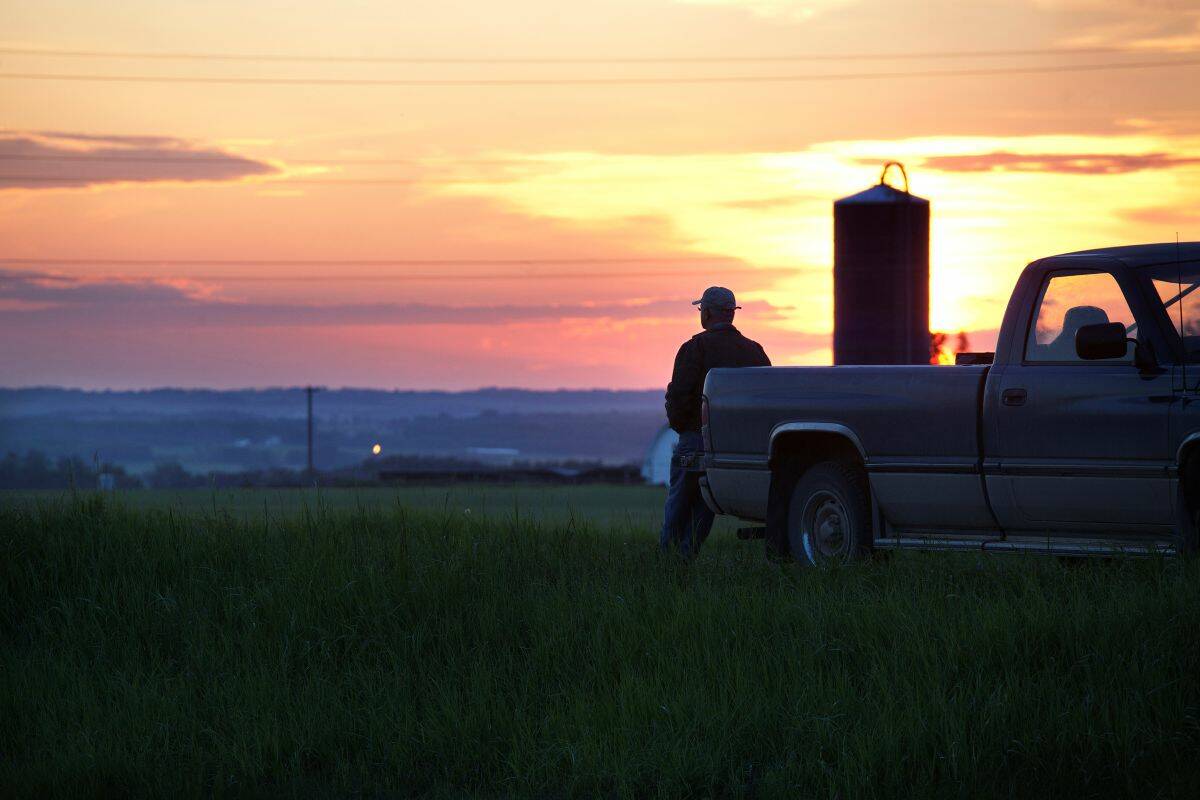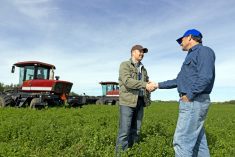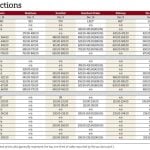In early October, Robert and Angela Semeniuk woke to deep snow blanketing their picturesque farm at Smoky Lake, north of Edmonton. Their hearts sank. Silence had descended on a scene that was supposed to be humming with harvest, leaving more than half of their canola in the field.
But on that cold, grey fall morning, the Semeniuks didn’t crawl back into bed with a groan and pull the sheets over their heads. Instead, they turned on their computers, called up their spreadsheets, and started crunching new numbers.
Read Also

It doesn’t have to be the end for your farm
Options for farmers without successors to pass on the farm.
They poured over Angela’s monthly updates of 18-month cash-flow statements as they drank their coffee. By the time their two children, Tristan (9) and Gabrielle (11), came for breakfast, the Semeniuks knew fairly accurately where their 4,000-acre grain farm would be financially on August 31, 2017.
By the time the snowplow had cleared their road, they had looked at their annual budget and also revisited their overall strategic plan, including their 10-year capital acquisition plan. It gave them a guideline, a sort of roadmap to follow. “We knew what we needed to do and how to change to get through it,” says Robert.
A few days after the untimely snowfall, and after they’d done another round of number crunching, Angela called to set up a meeting with their bank’s loans manager. Once the manager saw the numbers, he was completely onside.
Robert grew up listening to his dad during the 1980s. “He always said not to hide anything from creditors.”
The couple says knowing the numbers builds confidence so it’s easier to talk to their lending institutions, and to develop a good working relationship. And it’s easier to sleep at night. “We’re in a high-capital business and a high-debt business,” says Robert. “Making sure our creditors know our business is our job, our responsibility.”
In return, the couple expects their bank to understand their business and how RAS Family Farms strives to be better than the provincial average in production, financial management and marketing. “They need to be a partner in our business,” says Robert.

Beyond their cash-flow statement, developed with their crop planning budgets, they also have a marketing plan and overall annual budgets, including a breakdown of the payments of loans and leases. Soon they hope to connect and directly link all these spreadsheets under one platform.
The vision and mission statements they wrote a decade ago have been an overarching guide, even when they made major changes. “Funny, every decision we’ve made, if you go back, it follows that vision. Even though we don’t always look it up or refer to it, it’s what drives us,” says Robert.
Planning has been the top contributor to their success. More specifically, this is a farm where planning, goal-setting and the numbers decide instead of emotions, says Angela, a chartered professional accountant. “If you take the time to plan, it focuses your future and will help you see the light at the end of the tunnel.”
“It’s given us something concrete to focus on,” Angela adds. “It doesn’t have to be 100 per cent correct right off the start, it’s evolving… But you have to write it down.”
The CAP
The original idea of a farm capital acquisition plan (CAP) came during the first few years they farmed, when Angela worked with the local municipality. Part of her job was to create a five-year capital acquisition plan, (for buildings, replacing graders, etc.) and the councillors then reviewed this document and incorporated it into their yearly budgets.
After Rob and Angela took the CTEAM program seven years ago, Angela decided to create a 10-year capital acquisition spreadsheet for RAS Family Farms to connect to their annual budget and their overall strategic planning. “Anyone can do it,” says Angela, “You don’t need to be an accountant.”
The 10-year CAP is a spreadsheet strategy of how they will buy or lease equipment and land. It’s based on the farm’s needs and approximate costs, equipment turnover rates and their budget, all guided by their overall strategic plan
Of course, grain farmers can’t depend on the kind of predictable income that a municipality gets to work with. Farm income varies, and the timing of expenses has to be variable too. For instance, the Semeniuks use a lot of used equipment so they have to be able to replace when good quality deals become available, not necessarily when a machine is due to be replaced. It all means they have to be flexible. “It (their CAP) is very much a living document,” says Robert.
For example, although they have a goal of replacing combines every five years, lately they’ve been doing it every three to four years because of trade-in values, the Canadian dollar value, interest rates, availability, and new technology.
However, year-end income tax position doesn’t come into play with their machinery purchasing decisions. They’ve set up proper lines of credit and calculate how much they’d save in income tax versus paying interest. “Why spend money on capital (that you can only depreciate for half the first year anyway) when you can pre-buy (other direct inputs)?” asks Angela.
It is important to them to stay on top of their equipment needs. The Semeniuks carefully track the repair and maintenance costs of all their equipment so they can see the trends and then red-flag anomalies, particularly if one starts to cost them.
Their machinery turnover spreadsheet contains the basic details about the piece, things like its age and the year it was purchased, the purchase price, where it was financed, whether it was a loan or a lease, and the terms including payments per year, interest rates, and any additional notes about the deal.
Their CAP acts as a guideline and forces a level of accountability, all backed up by these numbers. They update it at least once a year, so that when things come up, it can help them determine if a purchase makes sense, knowing that it’s easy to get enticed by a good deal, some new paint or new technology. Having this plan forces them to take a step back and look at the impact of the potential purchase on their financial plans and consider if there’s a better way to do it.
It’s a black and white voice of reason in a business full of green and red opportunities. “I’m always talking about doing something,” admits Robert. “This adds a level of patience… and yes, accountability.”
Plugging the numbers into a spreadsheet not only forces them to avoid knee-jerk purchases but also to look at different options. For example, if it’s time to replace a tractor, Angela can quickly compare the purchase price to leasing options and they can see the impact each choice will have on their cash flow. “Numbers don’t lie,” says Robert. “It has to make sense. And sometimes you have to say no, even if it is on the (CAP) plan.”
When Angela lists their machinery inventory, about half is leased, including two combines, a large front-wheel assist tractor, their sprayer and the tank part of their air drill. It took months to make a decision about replacing their seeding equipment because they looked at multiple options. It was a huge capital investment, and Angela compared five different combinations of leasing and purchasing and how each had an impact on the payments and their overall cash flow.
They also work closely with their local equipment salesman, who knows their general plans but not full disclosure. He knows enough of their plans to keep an eye out for good used equipment they’re planning to replace. Plus he knows the couple will need more details and options before they decide to go ahead. “You still have to shop around,” says Robert.
However, having a CAP doesn’t mean they’re handcuffed by numbers. If a good deal comes along before they are planning to replace, it can still happen. They just have a process in place that forces them to stop and see the impact this detour from their CAP will have on their farm’s financial position.
“It’s sometimes annoying when I want to buy something,” laughs Robert. “Even when I come up with crazy scenarios to convince us that we should buy it, you can’t make the numbers up. They don’t lie. ”
Although Robert is a self-professed gadget guy, he says with new technology it’s often difficult to see the value in the numbers. For example, sectional controls on a sprayer provide directly measurable savings, but syncing the grain cart to the combine, even though it increases overall harvest efficiency, is difficult to define in dollars.
Plus, it’s next to impossible to forecast 10 years from now and budget based on what new technology will be available and how much it will cost.
Strategic plan
A decade after first writing a strategic plan, the Semeniuks are starting to work on a major revision. Meantime, however, farmland prices have soared in Alberta, and farmland availability has declined. So instead of expanding, they switched the plan to diversify into more direct contracts and specialized crops.
Today, the Semeniuks grow wheat and malt barley (on direct contract), and sometimes oats, peas and canola — both commercial and specialty oil varieties. “We need to grow specialized crops to stay competitive,” says Robert.
“Not having the Wheat Board control everything has opened up more direct marketing opportunities for us,” adds Angela.

Until the beginning of last year, they also had a five-year-old sideline business: custom applying fertilizer. However, the numbers spoke again, and they decided to shut down that enterprise.
Although this enterprise helped with summer cash flow, it wasn’t contributing to their farm’s bottom line. It was time to replace the floaters, but with the current competition putting downward pressure on the number of acres available to spread and the margins per acre, the floaters wouldn’t pay for themselves.
The Semeniuks hope to start planning another additional enterprise with the 10-year strategic plan they are working on this winter, along with a clear eye on expansion. They also hope to eventually buy some land from retiring landlords, increasing their owned:leased ratio and locking in more of their production base.
The next strategy will also involve succession to potentially accommodate another generation. That generation would be the fifth generation of the family on their farm. “The land is our retirement, or our legacy,” says Robert.
Start planning
Having and updating a formal written business plan helps farmers invest in what works to achieve their specific goals, and positions their farms to seize new opportunities. According to Agri-Food Management Institute and Farm Management Council’s commissioned research Dollars and Sense: Measuring the Tangible Impacts of Beneficial Business Practices on Canadian Farms, top farmers from across Canada and all sectors write down their business plan, follow it and review it annually. In fact, they’re 50 per cent more likely to have and follow a formal business plan, monitor and use their costs of production, assess and manage their risks, and have a sound financial plan that includes budget goals.
However, according to a recent AMI Ispos Reid survey of Ontario farms, only about a fifth of farmers (i.e. 19 per cent) have a written formal business plan.
AMI executive director Ashley Honsberger says developing a business plan can be a way to start some important conversations and may help unite people around a common vision. “Starting with a blank slate is tough,” says Honsberger.
AMI is trying to make it easier for farmers to do a basic business plan, which is often the first step to other planning such as succession or human resource plans. There are many business plan templates available online with varying degrees of complexity.
Honsberger suggests that farmers without a business plan can start the process by doing some self-analysis on the AMI business scorecard found at www.takeanewapproach. Or you can also go to AMI’s new website, www.pledgetoplan.ca, to order a resource kit that breaks down the tasks by season.















